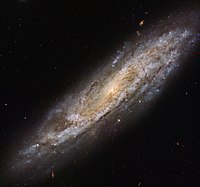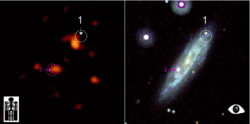Astronomy:NGC 2770
| NGC 2770 | |
|---|---|
 Image taken by the Hubble Space Telescope in 2020 | |
| Observation data (J2000 epoch) | |
| Constellation | Lynx |
| Right ascension | 09h 09m 33.622s[1] |
| Declination | +33° 07′ 24.29″[1] |
| Redshift | 1943±1 km/s[2] |
| Apparent magnitude (V) | 12.0[3] |
| Characteristics | |
| Type | SBc[4] |
| Apparent size (V) | 1.967′ × 0.511′[1] (NIR) |
| Notable features | Four supernovae[5] |
| Other designations | |
| LEDA 25806, MCG+06-20-038, NGC 2770, UGC 4806[6] | |
NGC 2770 is a spiral galaxy in the northern constellation of Lynx,[3] near the northern constellation border with Cancer. It was discovered by German-born astronomer William Herschel on December 7, 1785. J. L. E. Dreyer described it as, "faint, large, much extended 150°, mottled but not resolved, 2 stars to north".[7] NGC 2770 was the target for the first binocular image produced by the Large Binocular Telescope.[8]
The morphological classification of SBc[4] indicates a barred spiral with moderately-wound arms. The physical properties of this galaxy are similar to those of the Milky Way. The combined mass of stars in the galaxy is estimated at 2.1×1010 M☉, and it has a star formation rate of ~1.1 M☉ y−1. There are no apparent perturbations of the galaxy due to suspected interaction with the companion galaxy, NGC 2770B.[9]
As of 2017, up to four supernovae events have been discovered in this galaxy.[5] Three were of Type Ib: SN 1999eh, SN 2007uy, and SN 2008D.[9] The last of these was the first supernova detected by the X-rays released very early on in its formation, rather than by the optical light emitted during the later stages, which allowed the first moments of the outburst to be observed. It is possible that NGC 2770's interactions with a suspected companion galaxy may have created the massive stars causing this activity.[10] SN 2015bh, discovered in NGC 2770 in February 2015,[11] was either a Type II supernova or the hyper-eruption of a luminous blue variable.[5]
References
- ↑ 1.0 1.1 1.2 Skrutskie, Michael F. et al. (1 February 2006). "The Two Micron All Sky Survey (2MASS)". The Astronomical Journal 131 (2): 1163–1183. doi:10.1086/498708. ISSN 0004-6256. Bibcode: 2006AJ....131.1163S.
- ↑ van Driel, W. et al. (November 2016). "NIBLES: an H I census of stellar mass selected SDSS galaxies. I. The Nançay H I survey". Astronomy & Astrophysics 595: 43. doi:10.1051/0004-6361/201528048. A118. Bibcode: 2016A&A...595A.118V.
- ↑ 3.0 3.1 "NASA/IPAC Extragalactic Database". Results for NGC 2770. http://nedwww.ipac.caltech.edu/cgi-bin/nph-objsearch?objname=NGC+2770&img_stamp=YES&extend=no. Retrieved 2008-05-26.
- ↑ 4.0 4.1 Cite error: Invalid
<ref>tag; no text was provided for refs namedAnn2015 - ↑ 5.0 5.1 5.2 Thöne, C. C. et al. (March 2017). "SN 2015bh: NGC 2770's 4th supernova or a luminous blue variable on its way to a Wolf-Rayet star?". Astronomy & Astrophysics 599: 29. doi:10.1051/0004-6361/201629968. A129. Bibcode: 2017A&A...599A.129T.
- ↑ "NGC 2770". SIMBAD. Centre de données astronomiques de Strasbourg. http://simbad.u-strasbg.fr/simbad/sim-basic?Ident=NGC+2770.
- ↑ Seligman, Courtney. "NGC Objects: NGC 2600 - 2649". Celestial Atlas. https://cseligman.com/text/atlas/ngc27a.htm#2770. Retrieved 2020-09-07.
- ↑ "LBT Press Release - First Binocular Light". http://medusa.as.arizona.edu/lbto/firstbinocularlight_press_release.htm.
- ↑ 9.0 9.1 Thöne, Christina C. et al. (June 2009). "NGC 2770: A Supernova Ib Factory?". The Astrophysical Journal 698 (2): 1307–1320. doi:10.1088/0004-637X/698/2/1307. Bibcode: 2009ApJ...698.1307T.
- ↑ "Catching the Light of a Baby Supernova". http://www.gemini.edu/node/281.
- ↑ "List of Supernovae". IAU. http://www.cbat.eps.harvard.edu/lists/Supernovae.html. Retrieved 19 February 2017.
Further reading
- "Imposter or the Real Deal?" (in en). https://www.spacetelescope.org/images/potw2001a/. Retrieved 6 January 2020.
External links
- Astronomers Witness Supernova's First Moments
- NASA Astronomy Picture of the Day: Supernova Factory NGC 2770 (18 January 2008)
- NGC 2770 on WikiSky: DSS2, SDSS, GALEX, IRAS, Hydrogen α, X-Ray, Astrophoto, Sky Map, Articles and images
Coordinates: ![]() 09h 09m 33.7s, +33° 05′ 05″
09h 09m 33.7s, +33° 05′ 05″
 |


